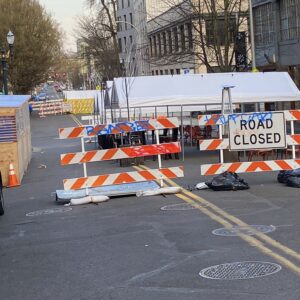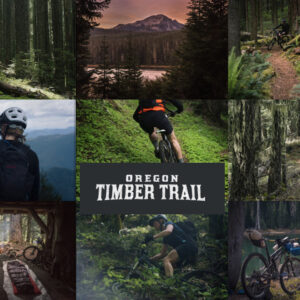
(Photo: Jonathan Maus/BikePortland)
Oregon’s tourism commission Travel Oregon has just announced $2.4 million in economic recovery grants to help create more Covid-safe tourism opportunities. Among the 60 winners, many of the awards will improve cycling trails and riding destinations all over the state.
Here are the projects (emphases mine):
Central Oregon Trail Alliance ($25,000) to construct a new multi-use trail near Sunriver to help disperse crowds from heavy-use areas and accommodate the use of adaptive mountain bikes.
Cog Wild Bicycle Tours ($7,962) to upgrade outdoor meeting areas in Bend and Oakridge to provide ADA accessible porta-potties and hand-washing stations.
Coos County ($100,000) to construct five miles of trail, improve physical distancing by building one-way loops and increasing signage on the Whiskey Run Trail System on the South Oregon Coast.
Advertisement
Harney County Chamber of Commerce ($26,869.80) for outdoor infrastructure to support a COVID-19 safe outdoor Skull 120 gravel mountain bike event.
Newport Trail Stewards ($79,500) for phase I of a project that will construct a series of multi-use and bike-specific trails, improve parking access, add restrooms and install wayfinding and trail signage at the Big Creek Trail System in Newport.
Port of Cascade Locks ($99,998) for parking lot and trail improvements to ease congestion on the Easy CLiMB family-friendly mountain bike trail in Cascade Locks.
Prineville-Crook County Chamber of Commerce ($11,622) to install a bike hub at the visitor center at the Prineville Crook County Chamber of Commerce.
And these are just the projects that focus specifically on cycling. Several I didn’t list here will improve the experience of visiting many of the small towns and other destinations that make Oregon such a magical place to ride a bicycle. Have a look at the full list here.
Last week we shared how the City of Portland won a $47,600 Travel Oregon grant to improve their outdoor dining street plazas.
An analysis by Dean Runyan & Associates of how the pandemic has impacted the Oregon tourism economy found that employment related to travel declined by 22% last year and total travel spending declined 50% between 2019 and 2020.
Do you part to help Oregon recover: Plan a bike trip today!
— Jonathan Maus: (503) 706-8804, @jonathan_maus on Twitter and jonathan@bikeportland.org
— Get our headlines delivered to your inbox.
— Support this independent community media outlet with a one-time contribution or monthly subscription.







Thanks for reading.
BikePortland has served this community with independent community journalism since 2005. We rely on subscriptions from readers like you to survive. Your financial support is vital in keeping this valuable resource alive and well.
Please subscribe today to strengthen and expand our work.
Wow, I’m pretty pumped about every one of the projects mentioned above.
These are great! Imagine- “Multnomah County ($100,000) to construct 10+ miles of sustainable, singletrack trail in Forest Park to reduce user conflict in other areas and enhance the off-road experience for cyclists.”
Any updates on the larger Wyeth Bench trail system? It’s been years since I have heard any news. It’d be a bummer to spend 100k on a parking lot (and “trail improvements”???) when congestion could be eliminated with 25 miles of sustainably-built, human-powered trails, located in an already-impacted public landscape next to a highway!
In case I’m unclear- I’m really hoping they build out the system we heard about years ago, and I really think it’d be a game changer for mountain bikers living in East county and East Portland.
I’m also kinda ticked to see other areas of the state getting money for great projects while the richest city in the state, from which much of the state’s tax revenue comes, apparently sits out the process.
I have mixed feelings about things like this. There’s no denying it’s fun.
However, it’s also contributed to an explosion of driving. Recreational traffic out of Portland is as bad as rush hour.
There’s a long list of places I used to love but don’t go to at all anymore simply because the traffic and crowding kills the whole reason to go. I suppose it’s inevitable as more people move in. But the induced demand thing is real. The more areas are developed, the more people come.
You’re suggesting induced demand in terms of developing recreational amenities, right? That’s an interesting way of framing the local explosion of interest in outdoor recreation. There’s a little bit of a chicken-and-egg problem here.
–
I’m more familiar with the following factors relating increasing demand for outdoor recreation amenities:
– I’ve read a national-level argument that young people are seeking social validation by mobbing Instagram-worthy scenic destinations (super-bloom, summit selfies) and activities (camping on the side of cliff, adventure sports). This tends to increase use, as well as concentrate that use in easily-reached, easily-photographed, scenic locations.
– Locally, I’m reading a lot about how the Forest Service has failed to maintain recreational facilities (thanks to defunding and fire-fighting), just as those networks are shrunk by wildfires, thus (again) concentrating use in the remaining facilities.
-I’ve seen other reporting that, locally, state tourism marketing has had the effect of concentrating use even further (for example, the Seven Wonders of Oregon campaign drove people to Smith Rock. . . exactly when the Park was so crowded that the OPRD was figuring out how to reduce use).
– The Central Cascades Wilderness Permits reflects both an increase in interest (social media), an increase in local population (Bend and Portland have both grown!), and an increase in national level marketing/reporting of the beauty of of the region. This increases use, at the same time that the National Forests in question have decreased the number and mileage of wilderness trails, thus concentrating use.
– National level reporting on the Pacific Northwest and the adventure possible on its great public lands has drawn a lot of people to the region (in other words, at this point our culture is self-selected toward individuals interested in outdoor recreation).
–
Basically, what I’m saying is that the grants featured in this article are more of a response to the increased demand (as well as increased some degree of increased concentration of use), rather than a cause of increased demand themselves. The factors listed above are so large, and some of the factors are far above our state’s ability to control. You didn’t say it explicitly, but I don’t think it would be effective to reduce investment in outdoor recreation, because the increase is here to stay, and further concentrating use would only worsen your subjective experience of crowding.